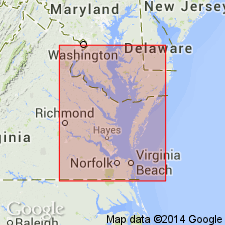
- Usage in publication:
-
- Yorktown formation*
- Modifications:
-
- Named
- Dominant lithology:
-
- Sand
- Clay
- AAPG geologic province:
-
- Atlantic Coast basin
Summary:
Yorktown formation, here named, described as sands and clays crowded with remains of calcareous shells, chiefly marine Mollusca. At Yorktown and on the James River are found the most highly fossiliferous beds of the Chesapeake Bay region. Fossils differ from those of underlying Miocene formations and evidently represent a distinct faunal aggregate. Thickness greater than 100 ft. Rests conformably on St. Marys formation. Assigned to top of Chesapeake group.
Source: GNU records (USGS DDS-6; Reston GNULEX).
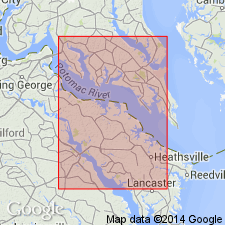
- Usage in publication:
-
- Yorktown formation*
- Modifications:
-
- Areal extent
- AAPG geologic province:
-
- Atlantic Coast basin
Summary:
Yorktown formation is geographically extended into eastern MD where it reaches Chesapeake Bay in the Calvert Cliffs. Overlies St. Marys formation.
Source: GNU records (USGS DDS-6; Reston GNULEX).
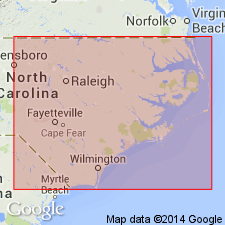
- Usage in publication:
-
- Yorktown formation
- Modifications:
-
- Revised
- AAPG geologic province:
-
- Atlantic Coast basin
Summary:
Formation, as extended into NC, may include elements of St. Marys formation as mapped elsewhere. In this report, Duplin marl is considered to be a shallow-water facies of the Yorktown; Waccamaw formation, considered as contemporaneous with Duplin, is also included in Yorktown.
Source: GNU records (USGS DDS-6; Reston GNULEX).
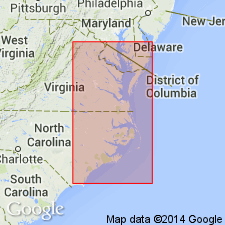
- Usage in publication:
-
- Yorktown Formation*
- Modifications:
-
- Age modified
- AAPG geologic province:
-
- Atlantic Coast basin
Summary:
Age of the Yorktown Formation changed from Miocene, to late Miocene and early Pliocene.
Source: GNU records (USGS DDS-6; Reston GNULEX).
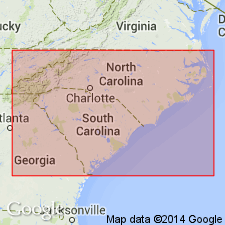
- Usage in publication:
-
- Yorktown Formation*
- Modifications:
-
- Areal extent
- Revised
- AAPG geologic province:
-
- Atlantic Coast basin
Summary:
Yorktown is geographically extended into eastern South Carolina, replacing Duplin Marl (or Formation) [now abandoned] and "Macks Formation" of local usage.
[Unit is not assigned to Chesapeake Group in South Carolina; Chesapeake is not extended into South Carolina.]
Source: GNU records (USGS DDS-6; Reston GNULEX).

- Usage in publication:
-
- Yorktown Formation*
- Modifications:
-
- Revised
- AAPG geologic province:
-
- Atlantic Coast basin
Summary:
Yorktown Formation is redefined to exclude former "lower part" of some authors including all beds above Calvert Formation (now included in Choptank, St. Marys, and Eastover (new name) Formations. Former "upper part" of some authors including all beds below Columbia Group (now included in Croatan Formation and other correlative units). Yorktown is divided into (ascending): lower part--Sunken Meadow Member (new name); upper part--Rushmere, Morgarts Beach, and Moore House Members (all three new names). Unconformably overlies Eastover Formation; underlies Croatan Formation or its correlatives.
Source: GNU records (USGS DDS-6; Reston GNULEX).
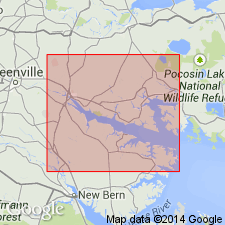
- Usage in publication:
-
- Yorktown Formation*
- Modifications:
-
- Age modified
- AAPG geologic province:
-
- Atlantic Coast basin
Summary:
Advance copy (1978). Yorktown Formation. Age changed from early Pliocene --to-- early and middle(?) Pliocene. [This manuscript was reviewed by GNU in June, 1978.]
Source: Modified from GNU records (USGS DDS-6; Reston GNULEX).
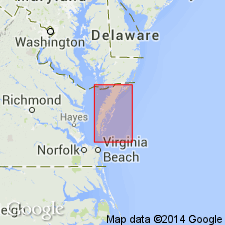
- Usage in publication:
-
- Yorktown Formation*
- Modifications:
-
- Revised
- Areal extent
- AAPG geologic province:
-
- Atlantic Coast basin
Summary:
Borehole data indicate Yorktown Formation is present in southern Somerset Co., MD, and northern Accomack Co., VA. It is divided into one formal and two informal members in this area: ascending, lower shelly sand member, consisting of shelly glauconitic quartz sand, 40+ ft thick; Tunnels Mill Member (new name), consisting of clayey silt, silty clay, and pebbly sand, 60 ft thick; and upper shelly sand member, containing large bivalves, 50 ft thick. Overlies Eastover Formation; unconformably underlies Accomack Member of Omar Formation, Stumptown Member of Nassawadox Formation or the Wachapreague Formation.
Source: GNU records (USGS DDS-6; Reston GNULEX).
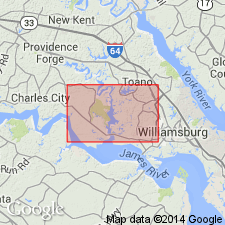
- Usage in publication:
-
- Yorktown Formation
- Modifications:
-
- Areal extent
- Overview
- AAPG geologic province:
-
- Atlantic Coast basin
Summary:
Yorktown extends from MD to central NC. Composite thickness is 43 ft. Sedley Formation is here abandoned as it is composed primarily of weathered and leached Yorktown sediments. Seven lithologic units are recognized within Yorktown. Top is marked by "chocolate layer." Disconformably underlies Bacons Castle Formation and unconformably overlies Eastover Formation, also of Chesapeake Group. Age is early and late Pliocene.
Source: GNU records (USGS DDS-6; Reston GNULEX).
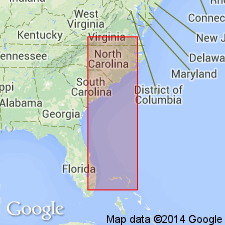
- Usage in publication:
-
- Yorktown Formation*
- Modifications:
-
- Age modified
- Biostratigraphic dating
- AAPG geologic province:
-
- Atlantic Coast basin
Summary:
Age on correlation chart for Yorktown Formation on Delmarva Peninsula and VA and NC is Pliocene (early and late). Ostracodes were collected from several sites. Samples 14 through 18 from Lee Creek Mine, Aurora, NC, were dated at between 4.5 and 3.0 Ma by Hazel (1983) and Snyder and others (1983) and were from upper part of Yorktown equal to lower N20 planktonic foraminiferal zone (Snyder and others, 1983). Samples from outcrops on Merherrin River (sample 11) and Roanoke River (samples 12 and 13) near Palmyra, NC, are equal to localities 15 and 62, respectively, discussed by Ward and Blackwelder (1980) who placed them in middle to upper part of Yorktown. Samples 9 and 10 come from locality 8 of Cronin and others (1989), also locality 61 of Ward and Blackwelder (1980) representing Rushmere Member of Yorktown. Samples 6 through 8 represent type locality of Moore House Member of Yorktown Formation at Yorktown and is also locality 1 of Cronin and others (1989) and locality 56 of Ward and Blackwelder (1980). Sample 5 comes from exposure of Yorktown near Williamsburg, VA. Samples 3 and 4 come from upper shelly sand member of Yorktown Formation on Delmarva Peninsula (Mixon, 1985). Dowsett and Gosnell (in press) examined Yorktown planktonic foraminifers and found an age range of from 4 to 3 Ma. Yorktown unconformably underlies Chowan River Formation dated at 2.4 to 2.0 Ma (Blackwelder, 1981; Cronin and others, 1984, 1989). Thus, Yorktown is no younger than about 3.0 Ma; unconformity between it and Chowan River Formation indicates marine regression between 3.0 and 2.4 Ma.
Source: GNU records (USGS DDS-6; Reston GNULEX).
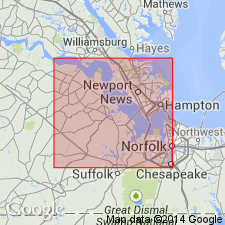
- Usage in publication:
-
- Yorktown Formation*
- Modifications:
-
- Biostratigraphic dating
- Overview
- AAPG geologic province:
-
- Atlantic Coast basin
Summary:
The Yorktown in southeastern VA contains a diverse and abundant planktonic foraminiferal assemblage and is dated at between 3.0 and 4.0 Ma based on the presence of DENTOGLOBIGERINA ALTISPIRA, SPHAEROIDINELLOPSIS, and GLOBOROTALIA PUNCTICULATA. This confirms correlation with the Duplin and Raysor Formation of SC and provides supporting evidence for an extensive middle Pliocene marine transgression on the Atlantic Coastal Plain.
Source: GNU records (USGS DDS-6; Reston GNULEX).
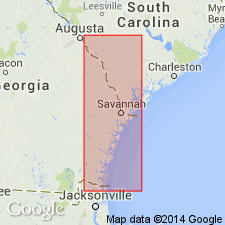
- Usage in publication:
-
- Yorktown Formation
- Modifications:
-
- Biostratigraphic dating
- Overview
- AAPG geologic province:
-
- Atlantic Coast basin
Summary:
Huddlestun (1988) suggested that Foraminifera indicated a late early Pliocene age for Wabasso beds indicative of Zone PL1 of Berggren (1973). GLOBOGERINA NEPENTHES suggests an age of no younger than 4.2 to 4.0 Ma. GLOBOGERINA MARGARITAE MARGARITAE suggests an age no older than about 5.7 Ma (J.E. Hazel, Louisiana State University, 1991, oral commun.). Sediments represent major late early Pliocene transgression, probably time equivalent to Sunken Meadow Member of Yorktown Formation in southeastern VA and northeastern NC. In southeastern GA, fossils in Wabasso beds consistent with Zone PL3 of Berggren (1973) are equivalent wholly or in part to Duplin Formation (in NC and SC), Raysor Formation (in SC and GA), Rushmere Member of Yorktown Formation (in VA and NC) (numerous references and L.W. Ward, Virginia Museum of Natural History, 1990, written Commun.), and Jackson Bluff Formation (FL). Rushmere and Morgarts Beach Members of Yorktown Formation are assigned a late Pliocene age on figure 6.
Source: GNU records (USGS DDS-6; Reston GNULEX).
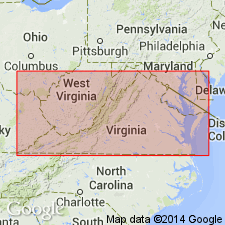
- Usage in publication:
-
- Yorktown Formation
- Modifications:
-
- Overview
- AAPG geologic province:
-
- Atlantic Coast basin
Summary:
Author states that the single Yorktown transgressive-regressive cycle model endorsed by many works, including Campbell and others (1975) and Ward and Blackwelder (1980) is now untenable. Consequently the members proposed by Ward and Blackwelder based on that model are in need of revision. The Rushmere, Morgarts Beach, and Moore House Members are not lithostratigraphic units. Their characteristic sediment types recur frequently through the Yorktown section. They are non-coherent when examined against the Krantz (1991) oxygen isotope model and are mappable only if restricted to the definitions of their stratotype sections. Only the Sunken Meadow is unchanged in this report. [Figure below has been modified from correlation chart included in report. Beds of Krantz (1991) shown to left. --We apologize. This figure is currently being reconstructed.]
Source: GNU records (USGS DDS-6; Reston GNULEX).
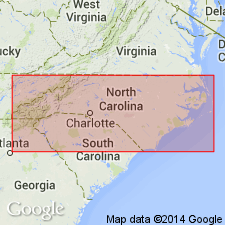
- Usage in publication:
-
- Yorktown Formation
- Modifications:
-
- Geochronologic dating
- Age modified
- AAPG geologic province:
-
- Atlantic Coast basin
Summary:
The material analyzed in this study consisted of long-ranging, nondiagnostic fossil shells and sandy, glauconitic limestones. Phosphatic materials gave inconsistent results. The age of deposition for each unit was assigned by comparing 87Sr/86Sr results with the seawater strontium curve. Analysis of Yorktown and Croatan results enabled the authors to define the age of these units precisely and to suggest slightly younger ages than those based on detailed paleontologic studies. At Aurora, the Yorktown gives a latest Pliocene-earliest Pleistocene age, while the Croatan gives a middle Pleistocene age.
Source: GNU records (USGS DDS-6; Reston GNULEX).

- Usage in publication:
-
- Yorktown Formation
- Modifications:
-
- Overview
- AAPG geologic province:
-
- Atlantic Coast basin
Summary:
Chesapeake Group is shown undivided on the State map. Its formations--Chowan River, Yorktown, Eastover, St. Marys, Choptank, and Calvert--are discussed in the accompanying text. The Yorktown is described as bluish-gray and brownish-yellow sand, fine- to coarse-grained, in part glauconitic and phosphatic, commonly very shelly, interbedded with sandy and silty blue-gray clay. In lower York and James River basins, unit includes cross-bedded shell hash. Mollusks include GLYCYMERIS SUBOVATA, CHESAPECTEN JEFFERSONIUS, CHESAPECTEN MADISONIUS, MERCENARIA TRIDACNOIDES, PANOPEA REFLEXA. Coarse-grained sand and gravel facies of the Yorktown in updip areas is separately mapped. Members not discussed. Thickness is 0 to 150 ft. Age is early Pliocene to early late Pliocene.
Source: GNU records (USGS DDS-6; Reston GNULEX).

- Usage in publication:
-
- Yorktown Formation*
- Modifications:
-
- Overview
- AAPG geologic province:
-
- Atlantic Coast basin
Summary:
Yorktown Formation in the Aurora district, NC, is readily subdivided into lower and upper portions on the basis of lithology. Lower Yorktown is characteristically phosphatic, grading upward from a muddy, gravelly, medium to coarse, phosphatic quartz sand into a very muddy, fine to medium quartz sand with progressively smaller percentages of phosphate. Contact between the upper and lower parts is marked by a weakly cemented carbonate zone approximately 0.65 m thick. Upper Yorktown is a gray, clayey quartz sand with occasional interbeds of sandy clay. The Yorktown section exposed at the Lee Creek Mine appears to correspond with the Sunken Meadow and Rushmere Members as defined by Ward and Blackwelder (1980).
Source: GNU records (USGS DDS-6; Reston GNULEX).
For more information, please contact Nancy Stamm, Geologic Names Committee Secretary.
Asterisk (*) indicates published by U.S. Geological Survey authors.
"No current usage" (†) implies that a name has been abandoned or has fallen into disuse. Former usage and, if known, replacement name given in parentheses ( ).
Slash (/) indicates name conflicts with nomenclatural guidelines (CSN, 1933; ACSN, 1961, 1970; NACSN, 1983, 2005, 2021). May be explained within brackets ([ ]).

